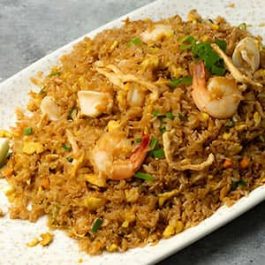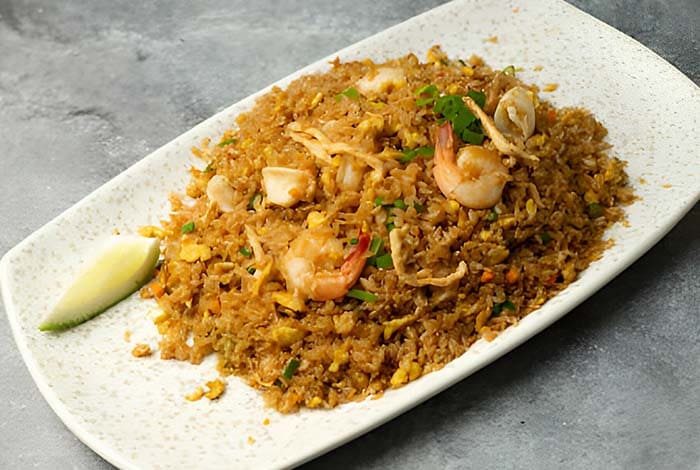Fried rice is one of the world’s most beloved comfort foods—simple, versatile, and endlessly customizable. Originating in China as a way to reuse leftover rice, fried rice has evolved into a culinary staple found across Asia, the Americas, and even Africa. From busy weeknight dinners to luxurious restaurant plates, this dish has something for everyone. In this ultimate guide, you’ll learn how to master fried rice step by step—from cooking techniques to flavor tips, nutritional tweaks, and global variations.
What is Fried Rice?
At its core, fried rice is a dish made by stir-frying cooked rice in a hot wok or pan, usually with vegetables, protein, and seasonings. The genius lies in its simplicity: take yesterday’s rice and transform it into something fresh, hot, and delicious in minutes.
It’s not just a dish—it’s a canvas for creativity, allowing cooks to experiment with flavors, textures, and ingredients from different cultures.
Why Use Leftover Rice?
Fresh rice is moist and steamy—great for curries or sushi, but not for frying. When you chill rice overnight in the fridge, excess moisture evaporates and the starches firm up. This gives the grains a slightly dry texture that’s perfect for frying. The result? Fried rice that’s fluffy, crispy in spots, and never mushy.
Learn how to cook rice perfectly every time for the best fried rice base.
Essential Ingredients
1. Rice
-
Best types: Long-grain white rice, Jasmine, or Basmati.
-
Alternative: Brown rice for a nutty flavor and fiber boost.
2. Vegetables
-
Classic combo: peas, carrots, and onions.
-
Others: bell peppers, scallions, corn, bean sprouts, or even chopped spinach.
3. Protein Options
-
Eggs: The gold standard in fried rice.
-
Meat: Chicken, pork, beef, shrimp, or even sausage.
-
Vegan: Tofu, tempeh, or edamame for plant-based goodness.
4. Sauces & Seasonings
-
Soy sauce: Adds umami and salt.
-
Oyster sauce: Depth and richness.
-
Sesame oil: Nutty aroma—add at the end!
-
Garlic, ginger, black pepper, chili flakes: For punch and complexity.
Tools You Need
-
A wok is ideal for even heat distribution and high-temperature cooking.
-
A wide frying pan also works, as long as it can get hot.
-
Use silicone or wooden utensils to avoid scratching non-stick surfaces.
Step-by-Step: How to Make Fried Rice
1. Prep Everything First
-
Chop all vegetables.
-
Crack and beat the eggs.
-
Slice proteins into bite-sized pieces.
-
Measure out sauces before you begin.
2. Heat the Pan Properly
-
High heat is essential.
-
Add a high-smoke-point oil (e.g., vegetable or peanut oil).
3. Cook the Aromatics
-
Start with garlic, onions, and ginger.
-
Sauté until fragrant, not browned.
4. Add Proteins
-
Add meat or tofu.
-
Stir-fry until cooked through, then push to one side.
5. Scramble the Eggs
-
Crack directly into the pan or pour in pre-beaten eggs.
-
Cook until just set, then mix into the protein.
Advertisement
6. Add the Rice
-
Break up clumps with your spatula.
-
Stir continuously for even cooking and crispy bits.
7. Add Sauce and Seasonings
-
Drizzle soy sauce and oyster sauce evenly.
-
Finish with sesame oil and green onions.
Pro Tips for Restaurant-Style Fried Rice
-
Use chilled rice: Room temperature or warm rice gets soggy.
-
Don’t overcrowd the pan: Work in batches if needed.
-
Let it sit for 20–30 seconds between stirs to create crispy edges.
-
Customize it: Add pineapple, kimchi, curry powder, or hoisin sauce for a unique twist.
Popular Fried Rice Variations Around the World
1. Chinese Fried Rice
-
Classic: Eggs, green onions, carrots, and soy sauce.
2. Thai Fried Rice
-
Features fish sauce, lime juice, and chili for a sweet-spicy flavor.
3. Nasi Goreng (Indonesia)
-
Dark, sweet soy sauce and shrimp paste for a deep umami hit.
4. Kimchi Fried Rice (Korea)
-
Spicy, tangy, and topped with a fried egg.
5. Yakimeshi (Japan)
-
Uses short-grain rice with pork, egg, and soy sauce.
Health Benefits and Nutritional Tweaks
Fried rice doesn’t have to be unhealthy. You can easily adapt it to suit your nutritional goals.
Healthy Hacks:
-
Use brown rice or cauliflower rice.
-
Go heavy on veggies and light on oil.
-
Choose lean proteins like shrimp, turkey, or tofu.
-
Use low-sodium soy sauce to reduce salt intake.
Nutritional advice for balanced meals to guide your ingredient choices.
FAQs
How do I keep my fried rice from getting mushy?
-
Use cold, day-old rice.
-
Avoid adding too many wet ingredients or sauces.
-
Cook in small batches to maintain high heat.
What oil is best for fried rice?
-
Neutral oils like canola, vegetable, or peanut oil.
-
Avoid butter or olive oil—they burn at high temperatures.
Can I freeze fried rice?
Yes! Let it cool completely, portion it out, and freeze in airtight containers. Reheat in a pan or microwave with a splash of water or broth.
Can I make it vegetarian or vegan?
Absolutely. Use tofu, tempeh, or plant-based meat alternatives. Skip oyster sauce or replace it with mushroom soy sauce for umami.
Final Thoughts
Mastering fried rice is a rewarding skill every home cook should have. It’s budget-friendly, endlessly adaptable, and packed with flavor. With the right ingredients, a hot pan, and a little technique, you can turn even the most basic rice into something spectacular.
Start with the basic recipe, play around with flavors, and soon you’ll be making fried rice better than your local takeout spot!

Fried Rice Recipe
Equipment
- Wok or large frying pan
- Spatula
Ingredients
- 2 cups cooked and chilled rice preferably long-grain like Jasmine or Basmati
- 2 tablespoons vegetable oil
- 2 large eggs beaten
- 1 medium onion finely chopped
- 1 cup mixed vegetables carrots, peas, and bell peppers, diced
- 2 cloves garlic minced
- 2 green onions thinly sliced
- 3 tablespoons soy sauce
- 1 tablespoon oyster sauce optional
- 1 teaspoon sesame oil
- Salt and pepper to taste
- Optional protein: 1 cup cooked chicken shrimp, or tofu, diced
Instructions
- Heat 1 tablespoon of vegetable oil in a wok or large frying pan over high heat. Add the beaten eggs and scramble until fully cooked. Remove them from the pan and set aside.
- Add the remaining tablespoon of oil to the pan. Sauté the onion, mixed vegetables, and garlic until just tender.
- Increase the heat to high and add the chilled rice. Stir-fry for a few minutes until the rice is hot.
- Add the scrambled eggs back to the pan along with the green onions, soy sauce, oyster sauce (if using), and sesame oil. Stir everything together and cook for another 2-3 minutes. Season with salt and pepper to taste.
- If using, add the optional protein and heat through.
Notes
- For the best texture, use rice that has been cooked and refrigerated until cold. This prevents the rice from becoming soggy when fried.
- Customize the recipe by adding your favorite vegetables and proteins. Leftover meat or vegetables from previous meals work great.
- For a vegetarian version, omit the oyster sauce and replace the protein with tofu or additional vegetables.
- If you like a bit of heat, add a splash of sriracha or diced chili peppers while stir-frying.
- Fried rice is best served immediately but can be refrigerated and reheated for up to two days.

